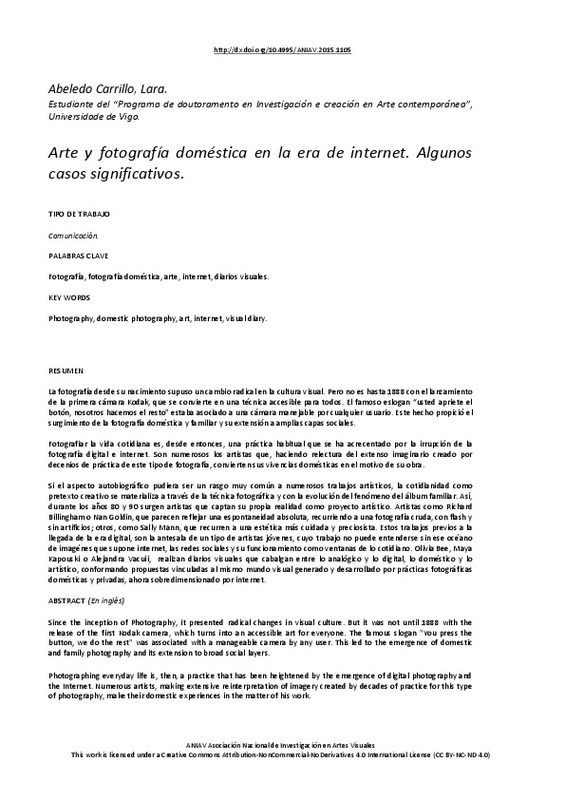JavaScript is disabled for your browser. Some features of this site may not work without it.
Buscar en RiuNet
Listar
Mi cuenta
Estadísticas
Ayuda RiuNet
Admin. UPV
Arte y fotografía doméstica en la era de internet. Algunos casos significativos
Mostrar el registro sencillo del ítem
Ficheros en el ítem
| dc.contributor.author | Abeledo Carrillo, Lara
|
es_ES |
| dc.date.accessioned | 2017-10-04T07:28:11Z | |
| dc.date.available | 2017-10-04T07:28:11Z | |
| dc.date.issued | 2015-11-26 | |
| dc.identifier.isbn | 9788490483411 | |
| dc.identifier.uri | http://hdl.handle.net/10251/88629 | |
| dc.description.abstract | [EN] Since the inception of Photography, it presented radical changes in visual culture. But it was not until 1888 with the release of the first Kodak camera, which turns into an accessible art for everyone. The famous slogan "You press the button, we do the rest" was associated with a manageable camera by any user. This led to the emergence of domestic and family photography and its extension to broad social layers. Photographing everyday life is, then, a practice that has been heightened by the emergence of digital photography and the Internet. Numerous artists, making extensive reinterpretation of imagery created by decades of practice for this type of photography, make their domestic experiences in the matter of his work. If the autobiographical aspect could be a common feature of many artworks, everyday life as a creative pretext materializes through the photographic technique and the evolution of the phenomenon of family album. Thus, during the 80s and 90s artists that capture their own reality as an artistic project arise. Artists like Nan Goldin and Richard Billingham, which seem to reflect an absolute spontaneity, using a raw photo with flash and without artifice; others, such as Sally Mann, who turn to a more careful and precious aesthetics. These prior to the arrival of the digital age, jobs are the prelude to a type of young artists whose work can not be understood without this ocean of images representing internet, social networks and how they work as windows of the everyday. Olivia Bee, Maya Kapouski or Alejandra vacuii, perform visual diaries that ride between analog and digital, the domestic and the artistic, forming proposals related to the same visual world created and developed by domestic and private photographic practices, oversized now online. | es_ES |
| dc.description.abstract | [ES] La fotografía desde su nacimiento supuso un cambio radical en la cultura visual, pero no es hasta 1888, con el lanzamiento de la primera cámara Kodak, que se convierte en una técnica accesible para todos. El famoso eslogan “usted apriete el botón, nosotros hacemos el resto” estaba asociado a una cámara manejable y a la desaparición de complejidades técnicas. Este hecho propició el surgimiento de la fotografía doméstica y familiar y su extensión a amplias capas sociales. Fotografiar la vida cotidiana es, desde entonces, una práctica habitual que la irrupción de la fotografía digital e internet ha sobredimensionado. Son numerosos los artistas que, haciendo relectura del extenso imaginario creado por decenios de práctica de este tipo de fotografía, convierten sus vivencias domésticas en el motivo de su obra. Si el aspecto autobiográfico pudiera ser un rasgo común a numerosos trabajos artísticos, la cotidianidad como pretexto creativo se apoya en la evolución técnica y en el desarrollo del fenómeno del álbum familiar. Así, durante los años 80 y 90 surgen artistas que captan su propia realidad como proyecto artístico. Artistas como Richard Billingham o Nan Goldin, que parecen reflejar una espontaneidad absoluta, recurriendo a una fotografía cruda, con flash y sin artificios; otros, como Sally Mann, recurren a una estética más cuidada y preciosista. Estos trabajos previos a la llegada de la era digital, son la antesala de un tipo de artistas jóvenes, cuyo trabajo no puede entenderse sin ese océano de imagénes que supone internet, las redes sociales y su funcionamiento como ventanas de lo cotidiano. Olivia Bee, Maya Kapouski o Alejandra Vacuii, realizan diarios visuales que cabalgan entre lo analógico y lo digital, lo doméstico y lo artístico, conformando propuestas vinculadas al mismo mundo visual generado y desarrollado por prácticas fotográficas domésticas y privadas, ahora sobredimensionado por internet. | es_ES |
| dc.format.extent | 8 | es_ES |
| dc.language | Español | es_ES |
| dc.publisher | Editorial Universitat Politècnica de València | es_ES |
| dc.relation.ispartof | II CONGRESO INTERNACIONAL DE INVESTIGACIÓN EN ARTE VISUALES | es_ES |
| dc.rights | Reconocimiento - No comercial - Sin obra derivada (by-nc-nd) | es_ES |
| dc.subject | Arte | es_ES |
| dc.subject | Producción artística | es_ES |
| dc.subject | Estética | es_ES |
| dc.subject | Teoría del Arte | es_ES |
| dc.subject | Gestión cultural | es_ES |
| dc.subject | Educación artística | es_ES |
| dc.subject | Investigación artística | es_ES |
| dc.title | Arte y fotografía doméstica en la era de internet. Algunos casos significativos | es_ES |
| dc.type | Capítulo de libro | es_ES |
| dc.type | Comunicación en congreso | es_ES |
| dc.identifier.doi | 10.4995/ANIAV2015.1105 | |
| dc.rights.accessRights | Abierto | es_ES |
| dc.description.bibliographicCitation | Abeledo Carrillo, L. (2015). Arte y fotografía doméstica en la era de internet. Algunos casos significativos. En II CONGRESO INTERNACIONAL DE INVESTIGACIÓN EN ARTE VISUALES. Editorial Universitat Politècnica de València. 52-59. https://doi.org/10.4995/ANIAV2015.1105 | es_ES |
| dc.description.accrualMethod | OCS | es_ES |
| dc.relation.conferencename | II Congreso Internacional de Investigación en Artes Visuales. |< real | virtual >| ANIAV2015 | es_ES |
| dc.relation.conferencedate | July 09-10,2015 | es_ES |
| dc.relation.conferenceplace | Valencia, Spain | es_ES |
| dc.relation.publisherversion | http://ocs.editorial.upv.es/index.php/ANIAV/ANIAV2015/paper/view/1105 | es_ES |
| dc.description.upvformatpinicio | 52 | es_ES |
| dc.description.upvformatpfin | 59 | es_ES |
| dc.type.version | info:eu-repo/semantics/publishedVersion | es_ES |
| dc.relation.pasarela | OCS\1105 | es_ES |








